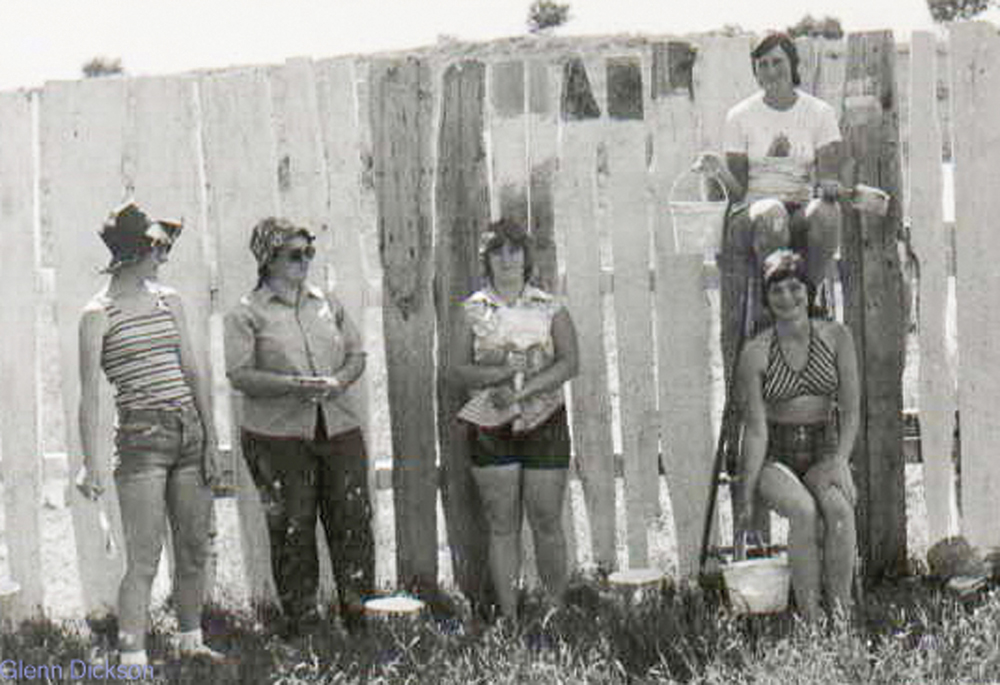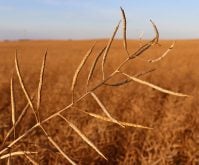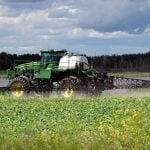The truck’s name was Little George. It was brilliant orange, the only colour available when, decades before online shopping, Wanda McConnell went to town to pick up paint.
The truck takes up the foreground of a grainy photo, taken in the summer of 1973 around the time of the Hamiota parade. In it, Little George is hooked to a hay rack adorned with an old outhouse taken from the community’s old McConnell school building grounds and painted during the slow crawl of the parade route. Four teenagers pose in front of the little structure while another sits in the truck’s bed. They’re all wearing government-issued yellow hard hats.
Read Also

Finally getting paid for sustainable farming?
Alberta project says they might have a line on a workable ecosystem credit model to reward farmers for sustainability, and Manitoba might be next

“I think wearing them made us feel important,” McConnell said.
Why it matters: Concerns over rural depopulation have lingered for decades.
The kids, all between Grades 11 and 12, were a work crew. They’d been hired by the provincial government to do farm beautification and maintenance tasks in their community for the summer. It involved a lot of painting.
Plenty of barns, fences and community centres in rural Manitoba got a facelift that summer, based on interviews with McConnell and other former Rural STEP program participants.
STEP, or the Student Temporary Employment Program, was the rural youth work program launched by the Schreyer NDP government in the mid-70s in an effort to bridge the employment gap for young people in rural Manitoba.
It consisted of teams of teenagers led by college student supervisors. Those teams did odd jobs that had been chosen by their local agriculture office. It also paid minimum wage, often a better lot than what a teen could do babysitting or working the family farm.
A 1973 release detailing the program also noted the potential for post-secondary credits, as that first program was being developed in concert with the University of Manitoba’s faculty of agriculture.

“For some time now, my department has been investigating and encouraging programs which will make it economically viable for Manitobans to remain in Manitoba, particularly on the farm,” said Manitoba’s ag minister at the time, Sam Uskiw, in the same release.
Uskiw further characterized STEP as “ an excellent way to give our young people an increased awareness of the variety of agriculture in our province and an opportunity to make a realistic commitment to rural life.”
Dying towns
Rural Manitoba in the 1970s was facing what has become a common refrain when new census data comes out: the population was dwindling.
It wasn’t specific to youth. People in general were leaving little rural towns in favour of Winnipeg and other population centres.

“Towns dying: Dauphin reeve,” wailed one Winnipeg Tribune headline from spring of 1973.
“We see the rural population on the farms and in the villages rapidly diminishing and disappearing into those vast jungels [sic] of concrete, over-crowding, pollution and crime that are our cities,” then-Reeve John Potoski is quoted as saying.
“Our small towns and villages are slowly dying, and our agricultural units are forced to attain the size of corporate structures in order to survive.”
The statistics bear out the basics of Potoski’s concern. While the population of Manitoba had grown by more than 250,000 between 1946 and 1971, the rural population had shrunk in every census year since the end of the Second World War, according to a 1973 University of Winnipeg study.
In 1971, the rural population numbered 302,000, or just under 31 per cent of the province’s total 989,000 people. That was down, both numerically and proportionally, from about 390,000 (almost 54 per cent) of Manitoba’s 727,000 people in 1946.
Former premier Edward Schreyer’s government was concerned that the shrinking rural population would have devastating economic effects.
A 1972 report warned the government that Winnipeg’s annual operating costs could increase by $55 million by 1981 if the exodus from the countryside didn’t slow down, according to a 1972 Winnipeg Tribune article.

In fact, the report prepared by the provincial agriculture department said, it would be cheaper for Winnipeg taxpayers if the province tripled or even quadrupled the annual spend of the agriculture department “to provide Manitoba farmers with adequate incomes.”
Without major changes to the province’s agriculture policy, the government at the time was warned that Manitoba could expect to lose 10,000 farmers throughout the ‘70s, and about 4,000 non-farm jobs in rural areas.
There was also an election coming up in 1973.
In response, the Schreyer government developed what it called the “Stay Option” policy, a series of programs tackling various issues of rural life and agriculture.
“The principle … is to give farm families and people living in rural communities the option of maintaining their present lifestyle instead of allowing economic pressures and short-sighted policies of centralization and consolidation to coerce people into leaving their homes,” said Schreyer in a 1973 speech delivered in Killarney.
The pillars of the policy, he said, were agriculture programs to help raise farm incomes as well as maintain services and investment in rural areas.
Rural STEP, which straddled both categories, was part of that suite of programs. It sought to give teens jobs in their communities, if only for the summer. Then, maybe they’d stay.
Planting the seed

Gary Enns was a fresh-faced college student when the province hired him in the summer of ‘72. He was tasked with surveying smalltown residents about their employment prospects. The province wanted to learn about the differences between the opportunities rural kids had versus those in urban areas, Enns said.
As fall approached, his boss asked him to use that data to prepare a short cabinet proposal.
Enns pitched a pilot program in which groups of high school students, led by university students, would do projects on farms around their rural communities. Farmers could apply to the district ag office to have a team work for them, and the ag rep would choose projects with the help of community advisors.
The students wouldn’t be able to work in primary production, as it would be awkward if one farmer could out-produce his neighbours because he’d landed a summer student. They also didn’t want to subsidize the farmers directly.
Saskatchewan had tried that, Enns noted.
“There seemed to be no way to stop farmers from hiring their own kids.”
Enns also built an educational component into the program. Teams were expected to take a half day each week to research and discuss aspects of the province’s Stay Option policy.
However, none of the Rural STEP students or supervisors the Co-operator spoke with remembered doing weekly educational work.
Cabinet members liked the proposal. They liked it so much that they ultimately decided to forgo the pilot and launch a province-wide program.
Half a century later
While the program may have had other benefits, the Rural STEP program appears to have done little to stem the flow of young people from the country to the city.
An analysis published in 2001 by Brandon University’s Rural Development Institute found that massive changes in the farm economy, brought on by technology and rural restructuring, had underpinned a shift to larger, fewer farms.
The study found that, between 1961 and 1996, 76 per cent of municipalities and local government districts had seen population declines of more than 10 per cent. About 59 per cent had seen declines of 30 per cent or more. The western half of the province was particularly impacted. There, some municipalities had near or more than half their population leave over the 35-year period.

Furthermore, there had been a significant “greying effect.” The number of children of zero-14 years in agro-Manitoba had dropped 8.3 per cent in rural municipalities and 6.7 per cent in communities. In contrast, those over 65 years old had jumped by 5.6 per cent in areas around Winnipeg, and 6.7 per cent elsewhere.
“We have arrived at a situation where all of rural Manitoba, except the region near Winnipeg, is feeling the effects of loss of people,” report author Richard Rounds said. “Even a return to good commodity prices will not alter the slow loss of population in rural Manitoba. Fewer and fewer people are present to shop or seek services in small communities, so fewer and fewer services are replaced when natural attrition occurs over time.”
More recent numbers show no grand gains. In terms of gross numbers, the 2021 census noted that Manitoba’s rural population was 339,000, but the total population had jumped even further. Just over 1.34 million people called Manitoba home that year, leaving the rural population floundering at about a quarter of the total.
That number had also slipped compared to a decade prior. In 2011, Statistics Canada reported that 27.6 per cent of Manitobans were living in a rural area. By 2016, that had dropped to 26.8 and, in 2021, dropped again to 25.3 per cent.
This series will continue in the Jan. 4 edition of the Manitoba Co-operator.
















